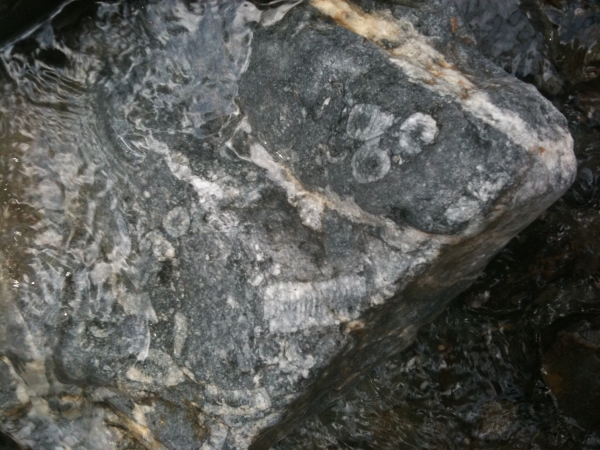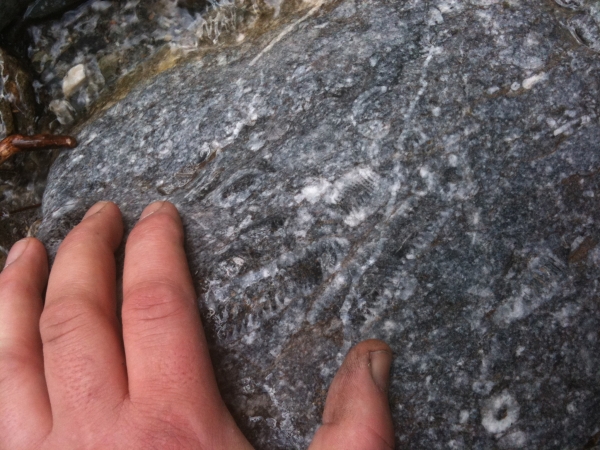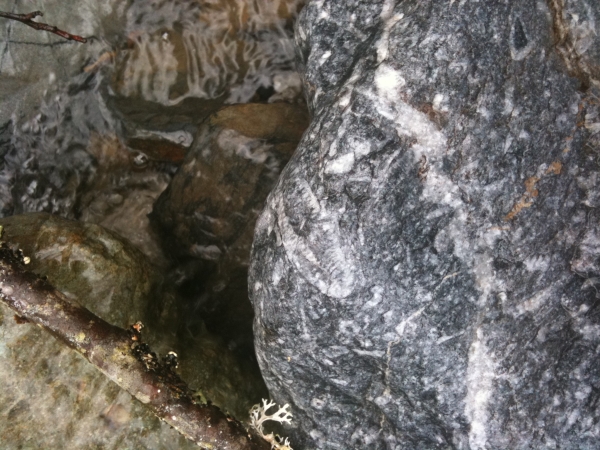Crinoids (sometimes refered to as "Sea Lilies") are a marine
animal, (not a plant as their nickname would imply) that live in
salt water. These were once abundant in ancient seas, but are still
found in modern day in certain locales. They somewhat resemble a
small underwater palm tree.

It is the columnal section of the crinoids that are found
fossilised in this area. Below are some images of what you are
looking for. It is easiest to find these when the rock is wet as
the contrasted colors make them much easier to spot. These are all
river tumbled specimens and the matrix that surrounds them is all
very large/heavy. You may be lucky enough to find a small rock
containing them, but most are more suitable for collecting via
photographs than physical collection.The rock is limestone and
mostly quite dark. The crinoids are all very white calcite.
Limestones are calcareous sedimentary rocks formed at the bottom
of lakes and seas with the accumulation of shells, bones and other
calcium rich goods. It is composed of calcite (CaCO3). The organic
matter upon which it settles in lakes or seas, are preserved as
fossils. Over thousands and millions of years, layer after layer is
built up adding weight. The heat and pressure causes chemical
reaction at the bottom and the sediments turn into solid stone, the
limestone. Limestone in the Chilliwack Group is mainly
recrystallized. This Lower Pennsylvanian* limestone is medium to
dark grey, argillaceous**, and where the primary texture is
preserved, is a calcarenite***. Most characteristic of this
limestone are large crinoid columnals commonly an inch or more in
diameter.


 * Pennsylvanian is a time period, not a geographical location.
Approx 320-290 Million years ago.
* Pennsylvanian is a time period, not a geographical location.
Approx 320-290 Million years ago.
** Argillaceous limestones are limestones consisting predominantly
of calcium carbonate.
*** Calcarenite is a rock formed by the percolation of water
through a mixture of calcareous shell fragments and quartz sand
causing the dissolved lime to cement the mass together.
In order to log this earthcache as a "find" you must email me the
answers to the following questions:
1:) Using a metal object (keys, coin, knife etc.) make a scratch
on one of the fossil bearing rocks. What did you scratch it with?
Does it leave a streak and if so what color?
2:) On your way into the cache site, where you turned off the
main road, you passed an old limestone quarry site. Limestone
blocks are often mined for use in construction (the pyramids in
Egypt are made from limestone blocks). Blocks were not mined from
this quarry, but crushed limestone was collected. Looking at the
size of these limestone chunks, what do you think this limestone
would be used for?
Optional task:) Please post a photo of any fossils you found,
with your log.